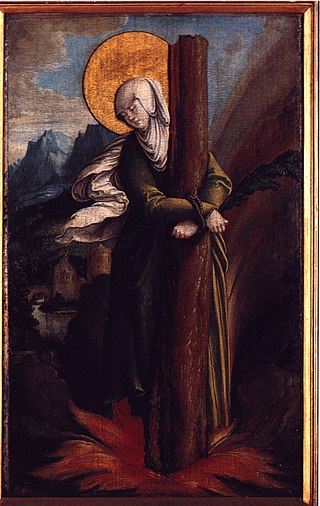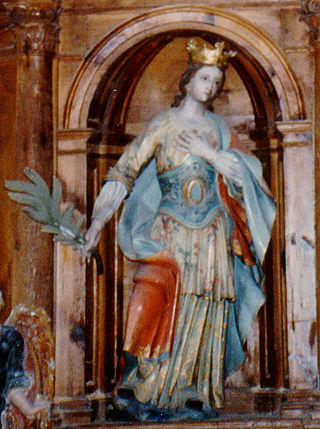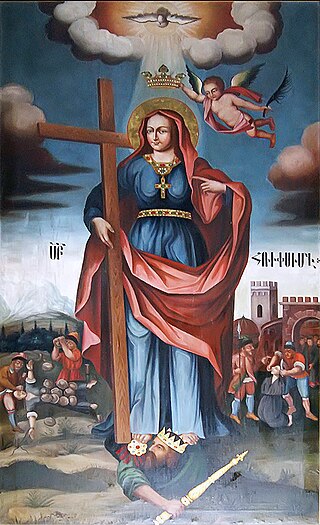Legend
She is said to have lived in the 3rd century and to have suffered martyrdom during the persecution of Diocletian, [1] but all information about her comes from a vita written not earlier than the 6th century. Later oral tradition has supplemented this with sometimes conflicting detail.
The simplest version of her legend is that she belonged to a family of high status: her father Calpurnius was prefect of the city of Rome (praefectus Urbis). Olympiadis, a high official, attempted to seduce her but was converted by her to the Christian faith, for which he was martyred. She then left her family to devote herself to prayer in seclusion, near the city of Amelia in Umbria, where she suffered martyrdom during the persecution of Diocletian and was buried. [2]
Other versions claim that she was martyred and buried in Civitavecchia.
Many miracles are attributed to her, one of which occurred during a sea passage to Centumcellae, the present Civitavecchia, when a sudden violent storm was calmed by her miraculous intervention. Firmina is said to have lived for a time in a grotto near the port, over which was later built the Forte Michelangelo.
She is often linked with two other virgin martyrs of Umbria, Saints Felicissima and Illuminata. It has been suggested [3] that all three are local cults of a single saint, the African martyr Firmina commemorated in the Martyrologium Hieronymianum on 9 and 10 October.

Pope Marcellinus was the bishop of Rome from 30 June 296 to his death in 304. A historical accusation was levelled at him by some sources to the effect that he might have renounced Christianity during Emperor Diocletian's persecution of Christians before repenting afterwards, which would explain why he is omitted from lists of martyrs. The accusation is rejected, among others, by Augustine of Hippo. He is today venerated as a saint in the Catholic Church and in the Serbian Orthodox Church.

Saint Afra was martyred during the Diocletian persecution. Along with Saint Ulrich, she is a patron saint of Augsburg. Her feast day is August 7. Afra was dedicated to the service of the goddess Venus by her mother, Hilaria. Through his teachings, Bishop Narcissus converted Afra and her family to Christianity. When it was learned that Afra was a Christian, she was brought before Diocletian and ordered to sacrifice to the pagan gods. She refused and was condemned to death by fire.

Columba of Spain was a virgin and nun who was born in Córdoba, Spain, and martyred around 853 by the Muslim rulers in Spain, during a persecution of Christians. She is a part of the Martyrs of Córdoba and venerated as a saint in the Catholic Church. Her feast day is September 17. Her cult was probably a combination of two virgin martyrs, Colomba of Spain and Columba of Sens, a third century French martyr.

Euphemia, known as the All-praised in the Eastern Orthodox Church, was a virgin martyr, who died for her faith at Chalcedon in 303 AD.

Crispina was a virgin martyr of Africa who suffered during the Diocletian persecution. She was born at Thagora, a town in the Roman province of Numidia, located in Taoura, Algeria. in North Africa.) She died by beheading at Theveste, in Numidia.

Susanna of Rome was a Christian martyr of the Diocletianic Persecution. Her existing hagiography, written between about 450 and 500 AD, is of no historical value and the relations it attributes to Susanna are entirely fictitious. It is probable that a real martyr named Susanna lies behind the literary invention.

Saints Cyprian and Justina are honored in the Catholic Church, Eastern Orthodox Church and Oriental Orthodoxy as Christians of Antioch, who in 304, during the Diocletianic Persecution, suffered martyrdom at Nicomedia on September 26. According to Roman Catholic sources, no Bishop of Antioch bore the name of Cyprian.

Saint Leocadia is a Spanish saint. She is thought to have suffered martyrdom and died on December 9, ca. 304, in the Diocletianic Persecution.

Saint Sabina was a saint and martyr of the early church. Her feast day is 29 August. She lived and suffered martyrdom at the beginning of the 2nd century in Rome.

Saints Marcellinus and Peter are venerated within the Catholic Church as martyrs who were beheaded. Hagiographies place them in 4th century Rome. They are generally represented as men in middle age, with tonsures and palms of martyrdom; sometimes they hold a crown each.
Rictius Varus was a Vicarius in Roman Gaul at the end of the 3rd century, around the time of the Diocletianic Persecution. The Roman Martyrology contains many references to the prefect Rixius Varus, who is said to have persecuted hundreds of Christians. In Christian hagiography he later repented and became a Christian martyr himself, and is regarded a Saint in the Eastern Orthodox and Roman Catholic Churches, with his feast day on July 6.

Restituta is a Berber saint and martyr of the Roman Catholic and Eastern Orthodox Churches. She was said to have been born in Carthage or Teniza and martyred under Roman Emperor Diocletian. The location and date of her martyrdom are not precisely known. She sometimes is considered one of the Martyrs of Abitinae, Roman Province of Africa, a group of North Africans including Dativus, Saturninus, et alia, who were martyred in AD 304.

November 23 - Eastern Orthodox liturgical calendar - November 25

Engratia is venerated as a virgin martyr and saint. Tradition states that she was martyred with eighteen companions in 303 AD.

Serapia was a Roman saint, a slave and martyr, also called Seraphia or Seraphima of Syria.

Hripsime, also called Rhipsime, Ripsime, Ripsima, Ripsimia, Ripsimus, Arbsima or Arsema was a martyr of Roman origin; she and her companions in martyrdom are venerated as some of the first Christian martyrs of Armenia.

Christina of Bolsena, also known as Christine of Bolsena, or in the Eastern Orthodox Church as Christina the Great martyr, is venerated as a virgin martyr of the third century. Archaeological excavations of an underground cemetery constructed over her tomb have shown that she was venerated at Bolsena by the fourth century.

Dorothea of Caesarea is a 4th-century virgin martyr who was executed at Caesarea Mazaca. Evidence for her actual historical existence or acta is very sparse. She is called a martyr of the late Diocletianic Persecution, although her death occurred after the resignation of Diocletian himself.

November 30 - Eastern Orthodox liturgical calendar - December 2
Saint Lewina was a British virgin and martyr who was put to death by Saxon invaders. Her feast day is 24 July.

















